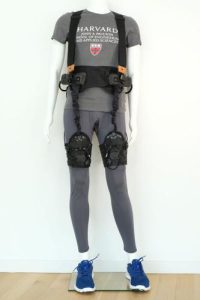
Parkinson’s is a debilitating neurodegenerative disorder affecting over 153,000 people in the United Kingdom and 9 million globally.
People living with Parkinson’s often find themselves suddenly losing the ability to move their feet or start shuffling their feet as they walk. This is one of the biggest contributors to falls. Currently, there are no particularly effective ways of curing the disorder. It can only be treated with a range of surgical, pharmacological, or behavioral therapies.
Researchers from Boston University and Harvard recently developed a novel wearable device they believe can stop the ‘freezing’ of Parkinson’s patients.
In the form of a robotic garment, the device can be worn around the thighs and hips; giving a gentle push to the hips as the legs move. This would help the wearer make a longer stride, helping them walk faster and further than they are used to.
‘We found that just a small amount of mechanical assistance from our soft robotic apparel delivered instantaneous effects and consistently improved walking across a range of conditions for the individual in our study,’ said Conor Walsh, professor of engineering and applied sciences and co-corresponding author of the study.
‘The research demonstrates the potential of soft robotics to treat this frustrating and potentially dangerous symptom of Parkinson’s disease and could allow people living with the disease to regain not only their mobility also their independence,’ Walsh explained.
A 73-year-old participant of the study had long suffered incapacitating freezing episodes that occurred over ten times a day causing him to fall frequently and preventing him from taking walks.
Once he tried the device, he found that he was able to walk without any freezing episode indoors, and few episodes outdoors.
He said ‘The suit helps me take longer steps and when it is not active, I notice I drag my feet much more. It has really helped me, and I feel it is a positive step forward. It could help me to walk longer and maintain the quality of my life.’
‘Our team was really excited to see the impact of the technology on the participant’s walking,’ commented Dr Jinsoo Kim, co-lead author of the study.
‘Our study participants who volunteer their time are real partners. Because mobility is difficult, it was a real challenge for this individual to even come into the lab, but we benefited so much from his perspective and feedback.’
The device feeds off the movements of the wearer to help increase their mobility.
‘Cable-driven sensors are worn around the waist and thighs, and using motion data collected by the sensors, algorithms then estimate the phase of the gait and generate assistance in tandem with the person’s muscle movement,’ explained Terry Ellis, professor in Boston University.
He also pointed out the device’s potential to better understand the concept of ‘freezing’.
‘Because we don’t really understand freezing, we don’t really know why this approach works so well. But this work suggests the potential benefits of a “bottom-up” rather than “top-down” solution to treating gait freezing,’ he said.
‘We see that restoring almost normal biomechanics alters the peripheral dynamics of gait and may influence the central processing of gait control.’
By Marvellous Iwendi
Source: NBC Right Now